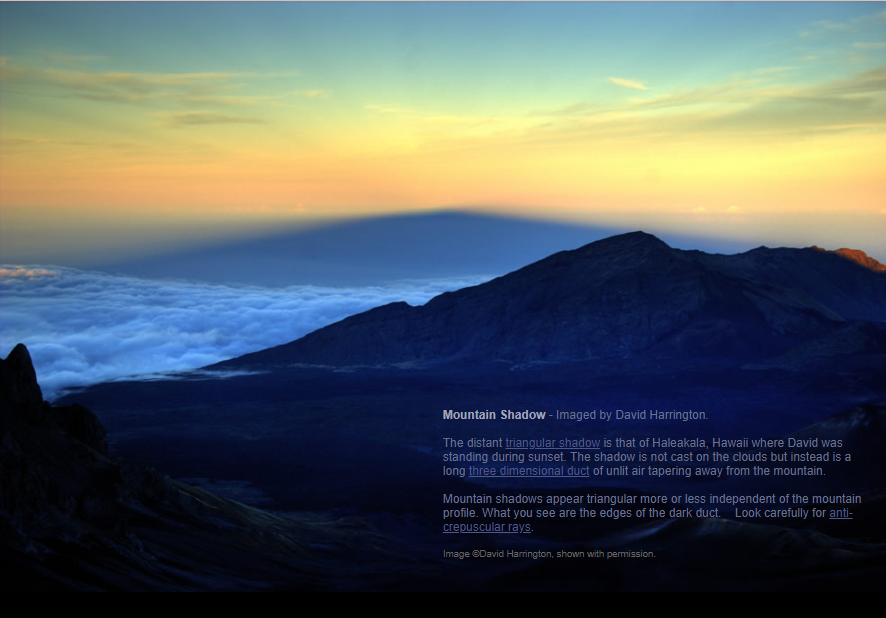Today's Feature - Haleakala Mountain Shadow
Today's Feature - Haleakala Mountain Shadow: A Phenomenon of Atmospheric Optics
Welcome to today's feature on Haleakala Mountain Shadow, a fascinating phenomenon of atmospheric optics. In this article, we will explore the intricacies of this natural occurrence and delve into the science behind it. So, let's embark on a journey to uncover the mysteries of this captivating spectacle.
As the sun begins to set over Haleakala, Hawaii, a remarkable triangular shadow emerges in the distance. This shadow, imaged by David Harrington, is not cast on the clouds but rather forms a long three-dimensional duct of unlit air that tapers away from the mountain. The edges of this dark duct are what create the triangular shape that captivates our gaze.
One intriguing aspect of mountain shadows is that they appear triangular, regardless of the mountain's profile. This is due to the unique way in which light interacts with the atmosphere and the topography of the landscape. The edges of the shadowed region form a distinct shape, leading to the triangular appearance. It is truly a testament to the interplay between light and shadow in our natural environment.
When observing Haleakala Mountain Shadow, it is worth noting another phenomenon known as anti-crepuscular rays. These rays are often visible in conjunction with the mountain shadow and add an extra layer of visual interest to the scene. Anti-crepuscular rays are sunlight that appears to converge at a point opposite the setting sun. They create a mesmerizing display of light and shadow, enhancing the overall beauty of the spectacle.
Now, let's dive deeper into the science behind Haleakala Mountain Shadow. The formation of this phenomenon can be attributed to several atmospheric optical processes. Here are some key factors that contribute to the creation of this captivating sight:
-
Atmospheric Refraction: As sunlight passes through Earth's atmosphere, it undergoes refraction, causing the light rays to bend. This bending of light plays a crucial role in the formation of the shadow and its distinct shape.
-
Scattering: The scattering of sunlight by air molecules and particles in the atmosphere also influences the appearance of the mountain shadow. This scattering can cause the shadow to appear less defined or create additional optical effects, such as the anti-crepuscular rays mentioned earlier.
-
Topography: The shape and elevation of the mountain itself play a significant role in shaping the shadow. The interplay between the angle of the setting sun, the mountain's profile, and the surrounding landscape contribute to the unique triangular form of the shadow.
-
Atmospheric Stability: The stability of the air mass surrounding the mountain can impact the visibility and shape of the shadow. Variations in temperature, humidity, and wind patterns can all influence how the shadow is perceived.
As we continue to explore atmospheric optics, it becomes evident that natural phenomena like Haleakala Mountain Shadow offer us a glimpse into the complexity and beauty of our world. The intricate interplay between light, atmosphere, and topography creates mesmerizing displays that leave us in awe.
Next time you find yourself witnessing a mountain shadow or any other atmospheric optical phenomenon, take a moment to appreciate the scientific principles at play. These phenomena serve as a reminder of the wonders that surround us and the limitless possibilities for exploration and discovery.
In conclusion, Haleakala Mountain Shadow stands as a testament to the captivating nature of atmospheric optics. Its triangular shape, formed by the edges of a dark duct tapering away from the mountain, creates a visually stunning spectacle. When combined with anti-crepuscular rays, this phenomenon becomes even more enchanting. By understanding the science behind this phenomenon, we gain a deeper appreciation for the intricate workings of our natural world. So, let's continue to marvel at the beauty of atmospheric optics and embrace the wonders that surround us.

Mountain Shadow - Imaged by David Harrington.
The distant triangular shadow is that of Haleakala, Hawaii where David was standing during sunset. The shadow is not cast on the clouds but instead is a long three dimensional duct of unlit air tapering away from the mountain.
Mountain shadows appear triangular more or less independent of the mountain profile. What you see are the edges of the dark duct. Look carefully for anti-crepuscular rays.
Image ©David Harrington, shown with permission.
Note: this article has been automatically converted from the old site and may not appear as intended. You can find the original article here.
Reference Atmospheric Optics
If you use any of the definitions, information, or data presented on Atmospheric Optics, please copy the link or reference below to properly credit us as the reference source. Thank you!
-
<a href="https://atoptics.co.uk/blog/todays-feature-haleakala-mountain-shadow-2/">Today's Feature - Haleakala Mountain Shadow</a>
-
"Today's Feature - Haleakala Mountain Shadow". Atmospheric Optics. Accessed on April 20, 2024. https://atoptics.co.uk/blog/todays-feature-haleakala-mountain-shadow-2/.
-
"Today's Feature - Haleakala Mountain Shadow". Atmospheric Optics, https://atoptics.co.uk/blog/todays-feature-haleakala-mountain-shadow-2/. Accessed 20 April, 2024
-
Today's Feature - Haleakala Mountain Shadow. Atmospheric Optics. Retrieved from https://atoptics.co.uk/blog/todays-feature-haleakala-mountain-shadow-2/.